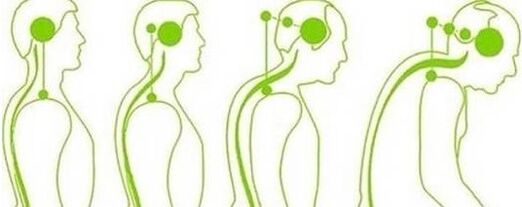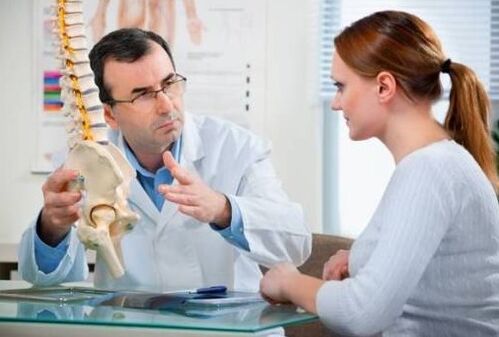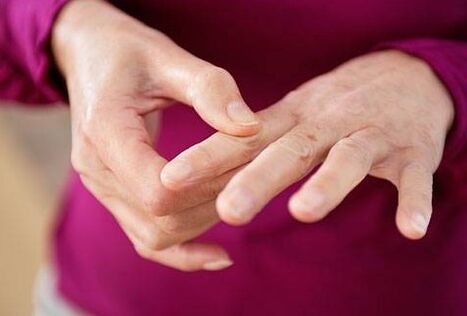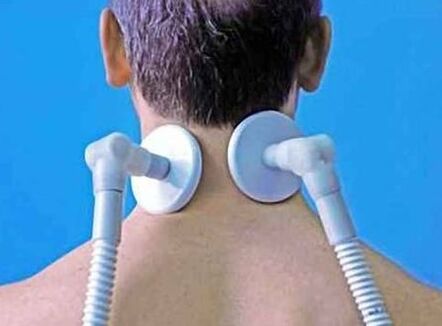Cervical osteochondrosis is most often developed in adults, but due to certain circumstances, a child can be made. If any signs of such a disease appear, contact a therapist or a narrow profile specialist.
Degenerative-dynight destruction of the cervical disk of the spine is characterized by the cervical osteochondrosis. The gradual progression of the disease leads to damage to intervertebral joints, adjacent vertebrae and league. Many people mistakenly believe that osteochondrosis is the deposition of salts. However, such a statement is fundamentally wrong. Salt can indeed be deposited into different joints, but with other pathologies such as gout development.
Thanks to the musculoskeletal system, the spine of the human neck, which consists of seven vertebrae, is kept. In this area, the muscles develop poorly, causing the long -term tension to appear and show cramps. In the future, the mobility of cervical vertebrae is limited. As a result of this condition, the spinal compartments are gradually destroyed, provoking the beginning of the first phase of osteochondrosis. In the absence of treatment, the disease continues to progress and causes all major lesions of the spine. In order to prevent complications, the first signs of pathology and appropriate measures should be taken into account.
Most often, people, such as the cervix osteocondrosis, are confronted with people whose lifestyle provides minimal physical activity and sedentary work. For such a person, the first qualities are most likely to be manifested at the age of 25-30. In children from infants to adolescence, the disease may occur less common, but it may also occur due to improper lifestyle or inheritance or other irritating factors.
Stages of the development and symptoms of pathology
The overall process of the development of osteochondrosis of the cervical spine is divided into 4 main stages, each of which is accompanied by certain symptoms. The treatment is completely dependent on the severity of the disease. For example, the first preclinical stage does not require drug treatment. To improve the patient's condition, it is recommended to radically review the lifestyle - perform physical exercises and eat correctly. The characteristics of this stage are: excessive tension of the whole back muscles, rapid appearance of fatigue, and mild but tangible pain in the turns and tendencies of the head. The most important disadvantage in this case is that few people have the right importance of such symptoms and therefore do not immediately turn to the hospital.
The following symptoms are characterized by second degree osteochondrosis:
- The pain becomes more intense when moving the head and periodically to the shoulders, hands, even to the lower back;
- Pain syndrome can occur in a relaxed state;
- There are clueless headaches;
- The attention is scattered and the level of working capacity is reduced.
All of the above symptoms are not unnoticed, so at this stage of the disease, the patient seeks medical attention. Strengthening pain is caused by a reduction in the distance between discs and nerve violations. An even greater worsening of the situation occurs in the third stage. In this case, the cervical pain is constantly disturbed, the muscles of the hands are very weak, and from time to time numbness occurs. As for the general symptoms, dizziness and weakness are the patient's daily companions. The cervical spine loses mobility.
The unbearable pain in the ears of the cervical, shoulders, arms, ears, the appearance of obvious signs of other diseases, indicates the beginning of the final fourth phase of osteochondrosis. At the same time, the intervertebral plates are destroyed and the pathological process continues along the spine, touching other classes. Such a degree of disease is difficult to treat, while the doctor's discretion may require surgical intervention. Thus, with the onset of symptoms such as cervical pain and head movements, hands, dizziness, nausea, headache, hands, and exhaustion and coordination, alarming signs of real health problems. Do not delay your doctor's visit, it is best to contact a therapist or an immediate neuropathologist.
In the process of progression of the cervical osteochondrosis, violation of the spine may occur. Different sensitive and motor disorders may occur, depending on which spine has suffered:
- partial or complete loss in the sensitivity of the oxy region, any part of the neck, in the shoulders and arms;
- Pain in any area of the neck, to the shoulders, forearms, hands, fingers;
- Numbness of the tongue and therefore speech is impaired;
- decrease in muscle tone of the head and neck;
- Respiratory problems, heart and liver pain.

The protruding edges of the vertebrae can print the arteries through which the blood enters the brain. Thus, the blood circulation in the brain is disturbed and other symptoms occur: sharp change in mood, insomnia, causing anxiety, fear, irritability. At the same time, with the cramps of the blood vessels, not only the headache but also the eye pain. Patients often note the appearance of "flies" in the face, sometimes fainting is possible.
Causes of the Cervical Osteochondrosis
The most common cause of the appearance of osteochondrosis of the cervix is considered to be a sitting lifestyle in the context of inadequate, unbalanced nutrition. Often, not only lazy people suffer from their nature, but also those whose profession is to spend a lot of time or in the same uncomfortable pose: office employees, vehicles drivers, etc. Such a lifestyle causes a constant burden on the cervical vertebrae, which causes muscle pain. The appearance of degenerative processes in discs is due to violation of metabolic processes and blood circulation. Further reasons for the development of cervical osteochondrosis are as follows:
- Overweight provoked by unhealthy nutrition;
- rheumatism, skoliosis, posture problems, flat legs;
- trauma of the spine and neck;
- regular stress, nervous surge;
- hereditary reason;
- Inadequate development of cervical vertebrae.
Too enthusiastic sports, which means that too intense physical activity can become the previous factor in the cervical osteochondrosis. The primary disease is most often a disk in these circumstances. The latter characterizes the dyspancial disorders between the vertebrae, primarily in the discretions of lumbar and cervix. In this case, osteochondrosis is the result of a disk. In addition to the exclusion of heavy physical efforts, the diagnosis requires complex, drug and physiotherapy treatment.

The consequences of progressive pathology
The complications that occur with the development of osteocondrosis of the cervix should be distinguished:
- In the spine, the hernia and the protrusion may occur in the third, fourth stage due to the rapid progress of the disease;
- The growth of bone tissue or the formation of osteophytes - often outstanding. The osteophytes have an irritating effect on the muscles nearby, increasing their voices. So the pressure on intervertebral plates increases. In addition, the osteophytes taught can cause the arteries to be reduced;
- Spinal dishes flattening - a decrease in the intervertebral hole leads to a decrease in height between intervertebral discs, risk of subluxation of cervical vertebrae with sharp turning the head;
- The displacement of spondylolistz or spinal novel does not occur as often as other complications, but even when occurring, even death can even cause death. A minimal change in the intervertebral disc is likely to lead to paralysis, resulting in a significant shift - to death.
Cervical osteochondrosis always causes an increase in blood pressure. In addition, the transition from one section of the underlying disease to another contributes to the progress of hypertension from the first to the third degree, with the pressure beyond the 180 mm signal. Treatment of hypertension directly helps to reduce the severity of the symptoms, but only temporarily. If you do not cure osteochondrosis, it is impossible to get rid of increased blood pressure. Periarthritis is complicated as complications between the 4 and 5 cervical vertebrae. This characterizes the nerve pinch, which is located in the connection of the shoulder joint and hand and hands. However, severe pain occurs in the shoulder and has a negative effect on the entire limb mobility. The manifestations of osteochondrosis cannot be based on signs of heart disease, such as angina pectoris, but due to diagnostic measures can distinguish the disease with great precision.
It is impossible to determine the cervical spine osteochondrosis by palpation and visual medical examination. Based on the history collected, the doctor can only assume that osteochondrosis has become a certain symptom. Diagnosis is required to confirm or refute such an assumption. To date, the most optimal method is MRI or magnetic resonance therapy. This method allows you to consider all bone structures, the presence of intervertebral hernia, the size of osteophytes, and other complications of the cervix osteochondrosis. In another, slightly less informative way, computer tomography. This allows you to determine the diagnosis, however, to determine the size of the hernia as its presence can be difficult.

Treatment of cervical osteochondrosis
Treatment of osteochondrosis of the cervix region is always complex and complex. Its duration and saturation depend on the development of the disease, the patient's unique characteristics and the presence of other simultaneous diseases. Between the main groups of medicines that are often prescribed in the second and further stages, it should be distinguished:
- Painkillers or painkillers. Stock -listed funds help to reduce the pain temporarily. With too much pain, the local blockade of Novocaine is used.
- Non -steroid anti -inflammatory drugs and steroid anti -inflammatory drugs. Non -sertoid agents are safer, have analgesic effect and can become alternative to the usual painkillers. In the event that they do not relieve pain, steroid drugs are used.
- Antidepressants and sedatives - Motherwort, valerian tincture. Their goal is due to two factors: if the cause of osteochondrosis is nervous overweight, or if the pain is so severe that it has a negative effect on the psyche. Such drugs should be used with strict observation, as each drug has many contraindications and addictive.
- It helps musorelaxant to relieve muscle cramps. Combined with anti -inflammatory drugs, they have an analgesic effect.
- Vasranszilators that contribute to the improvement of blood circulation.
- Medicines for increasing and normalizing immunity are ideal for vitamins B and C.
The complex of these drugs is symptomatic treatment. All recommendations of the doctor and passing the prescribed course help to eliminate pain and get rid of all the unpleasant manifestations of the disease. However, the therapeutic path does not end. When the main features are eliminated, which has exacerbated the quality of life, it can undertake the restoration of the cervix to minimize the risk of decline in the disease in the near future. Unfortunately, the huge mistake of many people is that they consider themselves completely healthy after the symptoms disappear and leave treatment. In this situation, osteochondrosis will certainly remind itself after a while.
Physiotherapy and traditional medicine
The following physiotherapy procedures are successfully used to treat cervical osteochondrosis:

- Medical Physical Education - only under the supervision of a qualified professional, as severe exercises for intervertebral discs can be even more damaged than tissues;
- Manual therapy - manual effect on certain areas of the patient's body;
- therapeutic massage;
- reflexology and kind of acupuncture;
- Electrophoresis, balneotherapy, laser therapy, UFO, etc.
There are many contraindications to each of the above procedures, which are particularly important for those who consider it a history of other diseases that are not related to osteochondrosis of the cervix. A decision on the adequacy of the application of a particular method remains with the attending physician. It may not be safe to implement such measures for your own free will. As far as traditional medicine is concerned, you can use the Saberfish grass, Bran. Figure: Salt intake is also recommended. The responsible approach to treating cervical osteochondrosis allows you to get rid of the disease. Allow this process to take a significant time, but only complex treatment minimizes the chances of developing the disease.

























